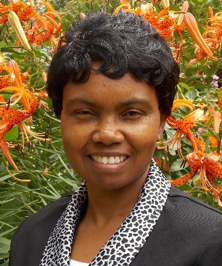Some of you may already be familiar with the millet, or you may have even made a meal or a snack with millets. But why has the millet gained so much attention lately? To understand the positive global impact the millet can have on the world’s hunger crisis, nutrition deficiency and climate change, we are excited to introduce you to one of our Board members, Serah Theuri, PhD, RD – Associate Professor of Food and Nutrition at the University of Southern Indiana.
As a member of the Society of Nutrition Education and Behavior (SNEB) Dr. Theuri’s goals are to partner with other nutrition educators worldwide to help foster behavior change, food systems and policy. Additionally, Dr. Theuri is a member of Society’s Division of International Nutrition Education (DINE), which is dedicated to bringing international topics and membership into all that SNEB does. Her role in DINE is to communicate with SNEB membership through DINE, on nutrition-related initiatives of the Economic and Social Council (ECOSOC) of the United Nations. The United Nations declared the year 2023 as the International Year of the Millets. Hence, Dr. Theuri’s efforts this year focus on promoting the International Year of the Millets through educational programs and activities. We were able to sit down with Dr. Theuri to learn about her upcoming SNEB Conference presentation and more information about the millet.

What date will you present in D.C.?
The conference organizers are still working on the specifics of the program agenda but as of early March, my presentation may be scheduled for July 21 or July 23.
What level of excitement are you feeling about the presentation?
I am very excited to present on this very important and timely topic at the SNEB International Conference 2023 in Washington DC as it really aligns with this year’s theme. The conference theme is: Empowering Food Citizens: Together for Nutrition and Food Systems Transformation. Reconnect, Re-nourish, Re-inspire.
Will you be asked questions from the audience after the presentation?
Yes, with a 90-minute session, I and my co-presenters from Malawi and the Philippines have planned for a Q and A session at the end of the program. This being a very new topic for most nutritionists and dietitians in North America, I anticipate questions related to millet’s nutritional profile, health benefits and where to find millet products.
What results do you expect to see from the presentation?
Because this is a conference for food and nutrition professionals, their role in promoting awareness and use of millets among clientele and networks may help create a demand in local communities over time. We hope there will be a gradual interest and acceptance of this ancient grain, in the same way we currently see the acceptance and popularity of other ancient grains such as Quinoa.
March is Nutrition Month and the theme is “Fuel for the Future”, which ties into sustainability and protecting the environment. Where do you see the millet headed in the next five years?
With support by the United Nations and member countries, food and nutrition professionals, policy makers, growers, researchers and other stakeholders are well positioned to elevate awareness and interest, to galvanize resources and promote the consumption of this underutilized grain, whose untapped potential holds promise for climate change and food security for many years to come.
What challenges do you anticipate with raising awareness of the millet?
Millets are not well known in North America so changing the mindset of nutrition professionals and consumers to adopt this new grain may be a challenge. Well accepted grains such as wheat, oats and corn are generally accessible and affordable unlike millet which will require considerable promotion, marketing and distribution efforts before it becomes a mainstream grain.
For readers that are committed to other grains on a weekly basis, why should they add/substitute this grain into their diet?
Millets are often called nutri-cereals due to their high nutritional content compared to other commonly grown cereals such as wheat, rice or corn. With rising global food prices, food insecurity and climate change, it makes sense to promote the untapped potential of millets. Millets are not only nutritious but are highly drought resistant and grow on poor soil. Millets are gaining popularity due to their versatility and ease of cultivation as a crop.
Are millets good for people living with diabetes?
Millets are low in simple carbohydrates and high in complex carbohydrates making it a low glycemic food. Compared to wheat, millet takes longer to digest thus making it a good choice for people living with diabetes. Additionally, millet is rich in soluble fiber which is important in reducing bad cholesterol in the blood. In the stomach, soluble fiber turns into a gel and absorbs cholesterol, allowing it to be safely removed as waste. Millets are a gluten-free grain making them a viable option for people with celiac disease or for people wanting to follow a gluten-free diet.
What is an appropriate portion of millets for a person on a weekly basis?
Nutritionists evaluate the adequacy of grain intake on a daily and not a weekly basis. One serving of cooked millet is equivalent to one standard cup. It is recommended that the average healthy person on a 2000 calorie diet consume 6-8 servings of grain varieties, where part of the grain can be millet.
What is your favorite millet recipe?
Lately, it is millet muffins and millet pancakes.




